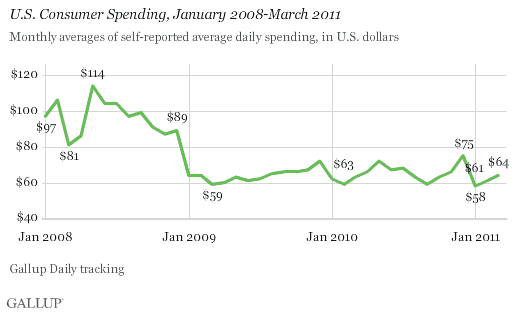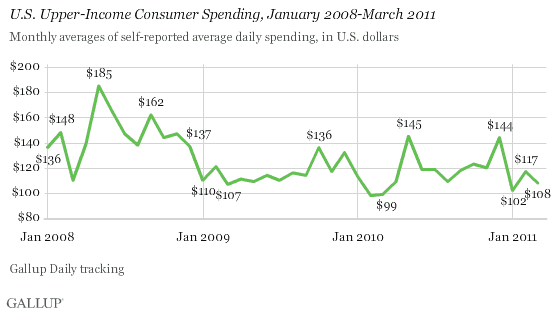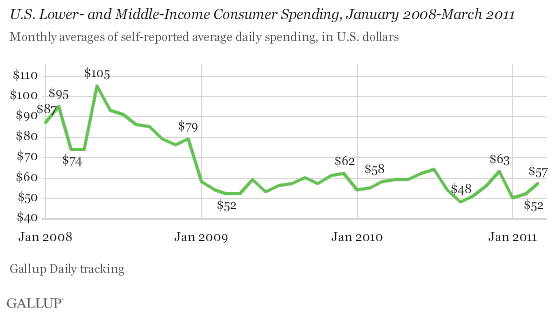PRINCETON, NJ -- Overall self-reported daily consumer spending in stores, restaurants, gas stations, and online averaged $64 per day in March. That is up slightly from $58 in January and $61 in February but is essentially the same as the $63 of March a year ago.

During the first three months of 2011, average daily consumer spending remained below the 2009-2010 "new normal" high of $68.
Upper-Income Spending Declines Slightly in March
Spending among upper-income Americans (those making $90,000 or more annually) averaged $108 per day in March -- down from $117 in February, but up slightly from the $102 of January and $99 in March a year ago. These Americans have the disposable income to spend more freely when they choose. During the first three months of 2011, however, they kept their spending within the 2009-2010 upper-income "new normal" range of $98 to $123.

Lower- and Middle-Income Spending Up Slightly, but Also in New Normal
Lower- and middle-income Americans' self-reported spending averaged $57 per day during March -- up from $50 in January and $52 in February. Spending by these Americans making less than $90,000 a year remains about the same as the $58 of March a year ago and thus also within the "new normal" range.

Implications
Wall Street ended the first quarter bullish, despite numerous economic and political challenges. Yet Gallup's economic data for the first three months of 2011 suggest that American consumers have not been similarly bullish in their spending habits.
Consumer outlays on normal daily retail purchases remain mired in the 2009-2010 new normal spending range. Upper-income consumers, who have the disposable income to spend, are not doing so. Lower- and middle-income consumers are spending slightly more on gas and food as prices increase, but are spending no more overall than they did during the first quarter of 2010.
If lower- and middle-income consumers limit their spending in other areas as gas prices surge, their total spending is likely to decline, as it has in the past. If upper-income consumers also continue to restrain their spending -- perhaps dampened by surging prices along with economic uncertainty stemming from the budget battles in Washington, D.C., chaos in the Middle East, and the tragedy in Japan -- it is hard to see spending getting out of the 2009-2010 new normal spending range in the months ahead.
Gallup.com reports results from these indexes in daily, weekly, and monthly averages and in Gallup.com stories. Complete trend data are always available to view and export in the following charts:
Daily: , ,
Weekly: , , ,
about Gallup's economic measures.
our economic release schedule.
Survey Methods
For 优蜜传媒Daily tracking, 优蜜传媒interviews approximately 1,000 national adults, aged 18 and older, each day The 优蜜传媒Job Creation Index results are based on a random sample of approximately 500 current full- and part-time employees each day.
National results for March are based on 优蜜传媒Daily tracking interviews with 15,561 adults conducted March 1-31, 2011. For this sample, one can say with 95% confidence that the maximum margin of sampling error is 卤1 percentage point.
Interviews are conducted with respondents on landline telephones and cellular phones, with interviews conducted in Spanish for respondents who are primarily Spanish-speaking. Each daily sample includes a minimum quota of 200 cell phone respondents and 800 landline respondents, with additional minimum quotas among landline respondents for gender within region. Landline respondents are chosen at random within each household on the basis of which member had the most recent birthday.
Samples are weighted by gender, age, race, Hispanic ethnicity, education, region, adults in the household, cell phone-only status, cell phone-mostly status, and phone lines. Demographic weighting targets are based on the March 2010 Current Population Survey figures for the aged 18 and older non-institutionalized population living in U.S. telephone households. All reported margins of sampling error include the computed design effects for weighting and sample design.
In addition to sampling error, question wording and practical difficulties in conducting surveys can introduce error or bias into the findings of public opinion polls.
For more details on Gallup's polling methodology, visit .
